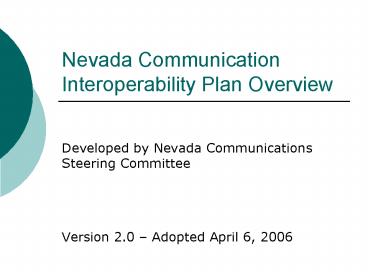Nevada Communication Interoperability Plan Overview - PowerPoint PPT Presentation
1 / 22
Title:
Nevada Communication Interoperability Plan Overview
Description:
Nevada Communication Interoperability Plan Overview Developed by Nevada Communications Steering Committee Version 2.0 Adopted April 6, 2006 – PowerPoint PPT presentation
Number of Views:220
Avg rating:3.0/5.0
Title: Nevada Communication Interoperability Plan Overview
1
Nevada Communication Interoperability Plan
Overview
- Developed by Nevada Communications Steering
Committee - Version 2.0 Adopted April 6, 2006
2
The Beginning
- 2 years in the making by the Nevada
Communications Steering Committee (NCSC). - NCSC stakeholders representing northern
southern NV, rural urban, state, county and
local governments. - Prompted by AB441 legislation.
- Developed with assistance from the SAFECOM office
of the Department of Homeland Security. - A living document revised as conditions change.
3
What is Interoperability?
- Interoperability is the ability of appropriate
officials and personnel to effectively
communicate by radio across jurisdictions and
with each other, when authorized, as needed and
in real time.
4
Who are Public Safety Agencies?
- Fire Services
- Law Enforcement
- Emergency Management
- Government Administrative Services
- Emergency Medical Services
- Public Health
- Health Care
- HazMat
- Private Industry
- Volunteer Organizations
- Public Safety Communication
- Public Works
5
Statement of Principles
- NCSC encourages maintains a governance
structure emphasizing transparency,
accountability and collaboration. - NCSC encourages comprehensive focus on key
success factors governance, SOPs, technology,
training and exercises. - NCSC reviews research on best practices/ lessons
learned. - NCSC not to be controlled by the State must
remain representative of entire NV public safety
community.
6
Interoperability Continuum - SAFECOM
- Designed to help the public safety community and
local, tribal, state and federal policy makers
address critical elements for success as they
plan and implement interoperability solutions. - Elements include governance, standard operating
procedures, technology, training/exercises and
usage of interoperable communications.
7
(No Transcript)
8
Long-Term Convergence
- The plan emphasizes convergence over time.
- Upgrading when equipment otherwise needs
replacement on maintenance schedules, not a
wholesale change out. - Preserving the publics existing investments in
communications technology. - Require new purchases comply with Plan.
- Allow existing equipment serve out its useful
life.
9
Long-Term Convergence (10-15 yrs)
10
Core Four Short Long-Term
- By connecting the 4 major trunked systems a
single virtual system is created. - Nevada Shared Radio System (NSRS)
- Southern NV Area Communication Council (SNACC)
- Washoe County Regional Communication System
(WCRCS) - Las Vegas Metropolitan Police (LVMPD)
11
The Core Four Concept
12
(No Transcript)
13
(No Transcript)
14
NV Radios by Proportion
15
Short-Term Gateways
- Short-term proposal is to link the two main
components of the Nevada radio system - 700/800 MHz (Core Four) 150 MHZ (rural)
- Some gateways currently exist, but need to be
expanded statewide. - Preliminary estimate for short-term 2.4M
- Cost does not include integration of other
frequency bands.
16
Short-Term Gateway (3-5 yrs)
17
Tech Standard for P25
- To move towards long-term convergence, a
technical protocol/standard must be adopted. - P25 is an open system, developed nationally for
over 15 years. - P25 establishes a common protocol, allowing
radios from different vendors to effectively
communicate. - P25 does not address radios operating in
different frequency bands or issues such as
standard operating procedures.
18
P25 Recommendations
- Longrange plan includes long-term convergence of
all radios within the state to digital, open
standards technology, implementing current
version of P25. - A phase-in timetable will be used.
- Exemptions considered upon written notice showing
good cause and approved by NV Homeland Security
Commission.
19
Assumptions
- Capable is defined as the ability to be quickly
upgraded via the loading of a software program to
actual P25 Common Air Interface operation. - Capable in this context does not mean the
equipment must actually operating in P25 mode
when purchased, rather that it be capable of
simple upgrade to such operational mode at a
future time. - In every case where purchase of P25 capability is
mandated, the equipment is for capability to
accommodate the most recently approved version of
the P25 standard.
20
TIMETABLE continued
- Effective July 1, 2009
- All radio equipment purchased for use in systems
operating below 512 MHz shall be P25 capable. - Mobile radios and portable radios purchased for
use in existing radio systems operating above
512MHz shall be P25 capable. - Core Four systems and any system directly
connected shall be P25 capable. - Effective July 1, 2011
- All radio systems and equipment in the State,
regardless of operating frequency or the system
it is purchased for, shall be P25 capable. - Effective July 1, 2013
- All radio systems and equipment in the state
shall be operating in P25 mode for normal,
operational voice communications. Multi-mode
operating, for interfacing with out-state
systems, may be retained and used as needed.
21
TIMETABLE
- Effective October 1, 2005 (FED YR 2006)
- All radio equipment (end user, consoles and
backbone) purchased using grant dollars shall be
P25 Common Air Interface capable. - The Core Four systems are exempt from mandatory
compliance until July 1, 2009. - Radio systems that do not use or apply for grant
funding are exempt until July 1, 2007. - Other exemptions granted by the Commission on a
case-by-case basis. - Effective July 1, 2007
- All mobile portable (end user) radio equipment
purchased shall be P25 capable. - All radio equipment (consoles backbone)
purchased shall be P25 capable.
22
Thank you
Questions?
Visit Website at http//nitoc.nv.gov/IT_NCSC.htm































